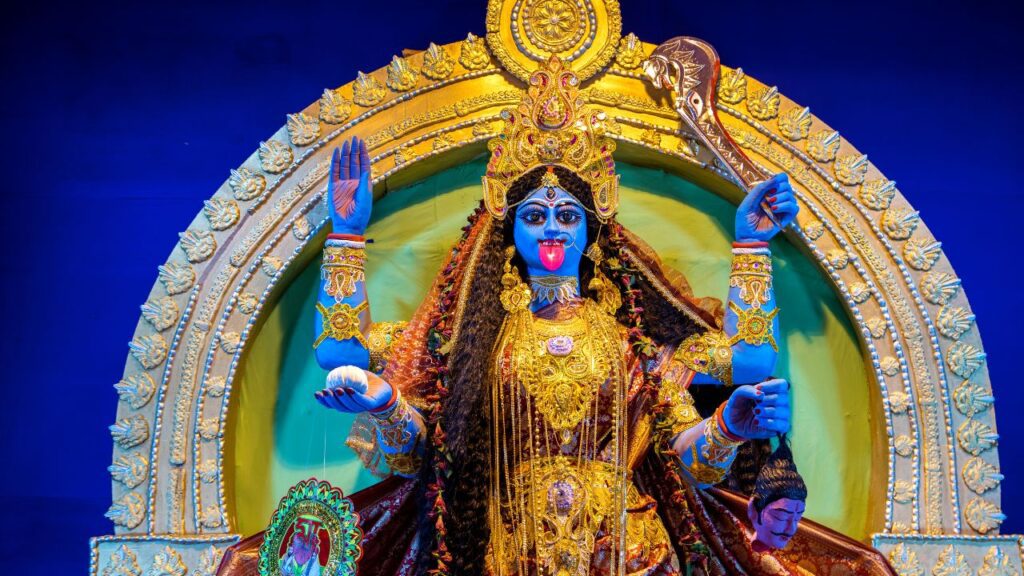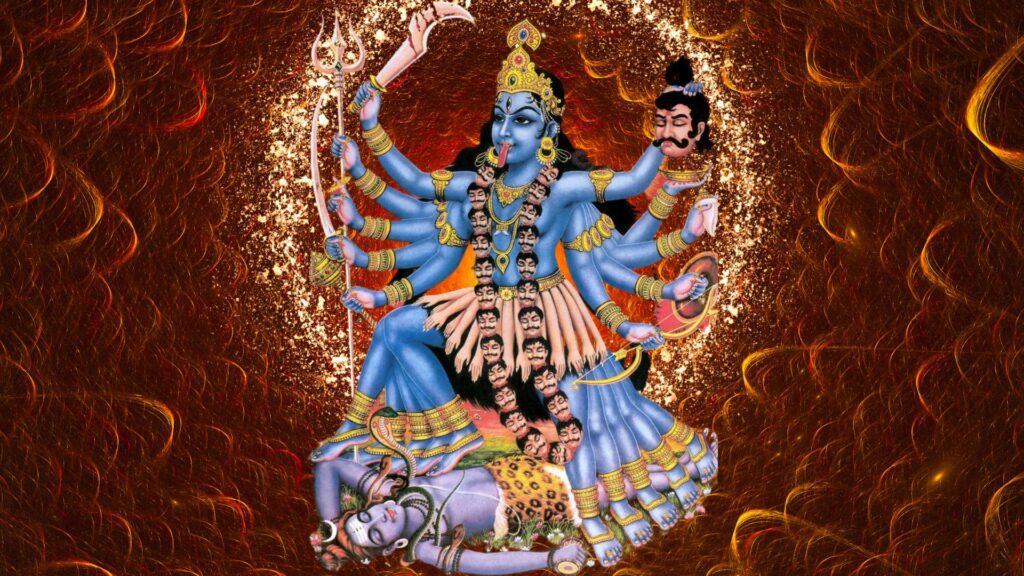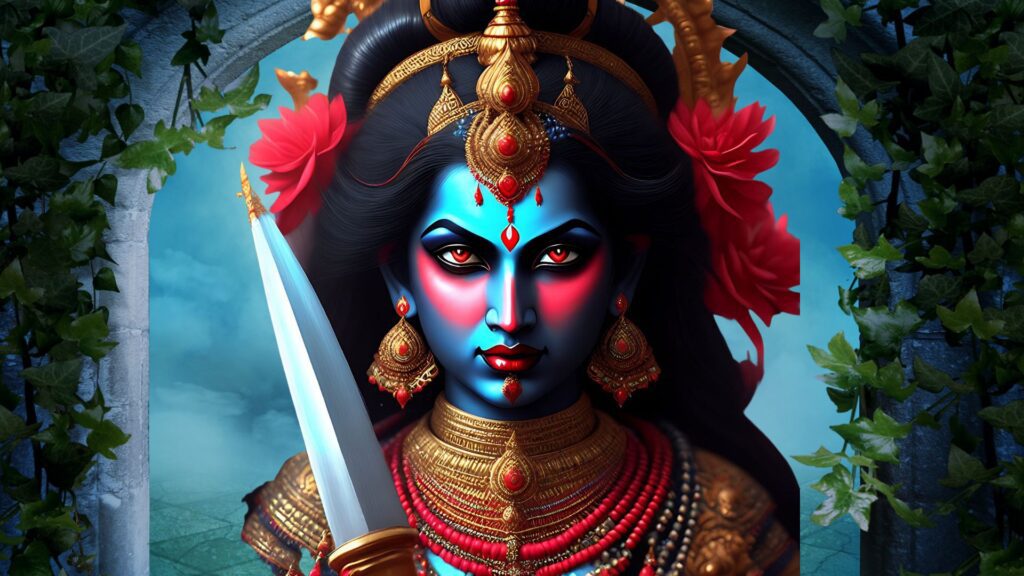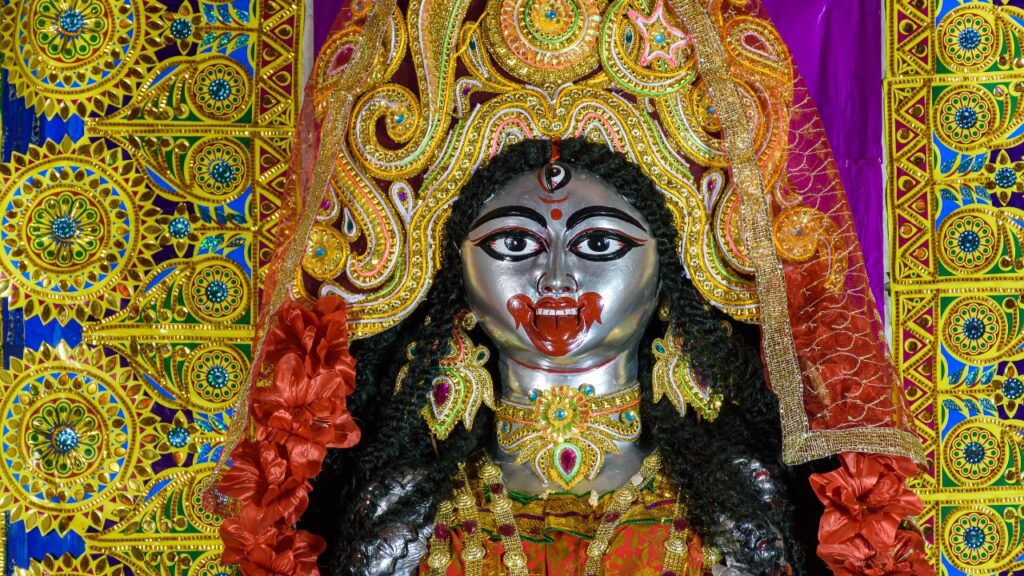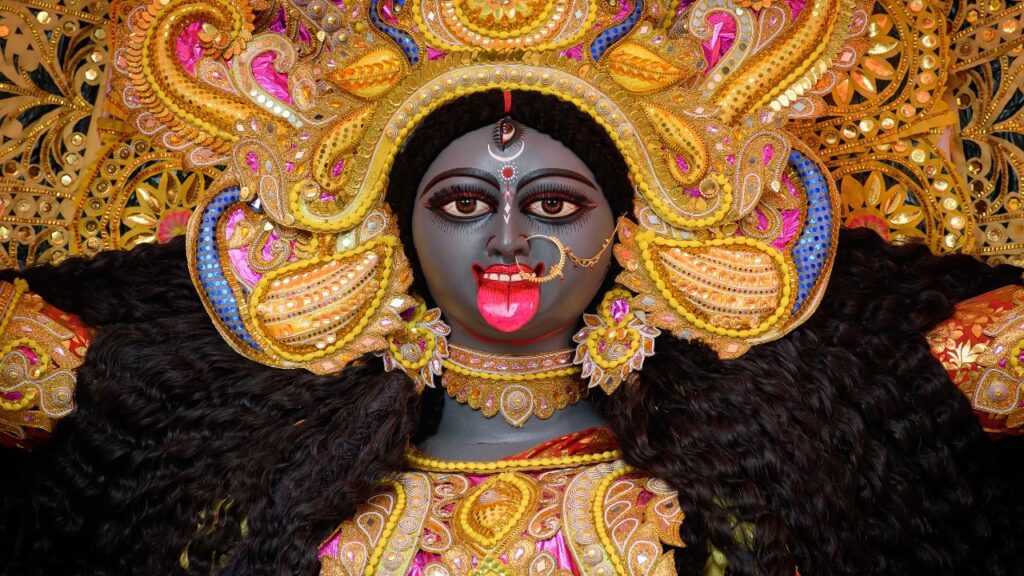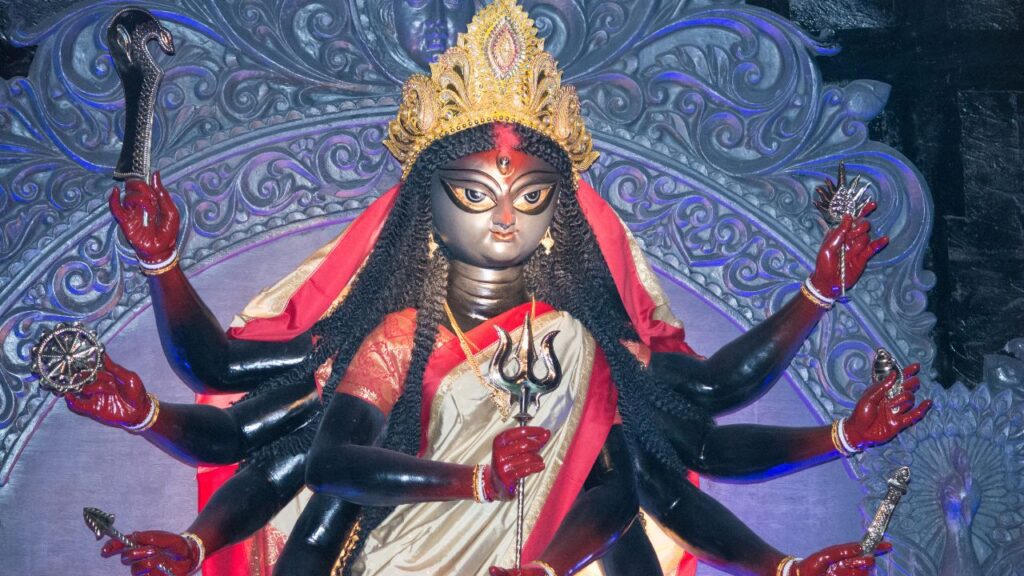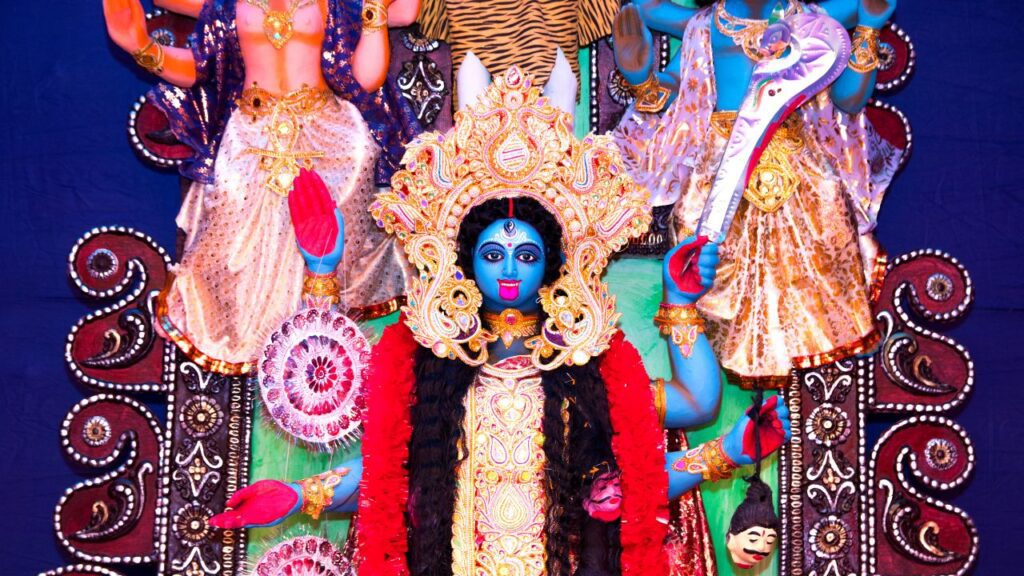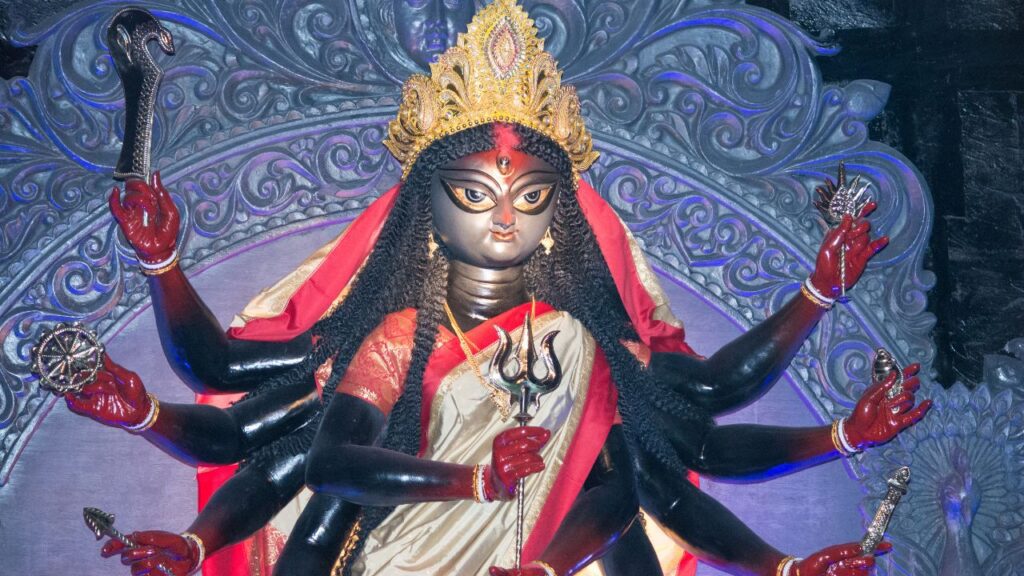kali worship : Spiritual Benefits of Worshiping Kali
Introduction
Hinduism honors the mysterious goddess Kali as a fundamental female deity under the additional names Kalika and the “Dark Mother.” Examining the complex tapestry of her mythos, we find a deity that embodies the cyclical character of time, change, and the duality of creation and destruction—that which transcends the bounds of good and evil. Her striking appearance, with a garland of skulls and a skirt of severed arms, belies a great spiritual relevance that has enthralled followers for millennia.
We will investigate the fascinating story of Goddess Kali in great detail, untangle the meaning behind her distinctive iconography, and find the great spiritual advantages that follow from committing oneself to her worship. We will travel to release the transforming power of this mysterious and amazing Goddess by means of a harmonic mix of historical background, mythological insights, and practical spiritual direction.
The Multifaceted Essence of Goddess Kali
Goddess Kali’s image is based on a great duality whereby her apparently terrible sides coexist in harmonic balance with her mothering, loving nature. Often referred to as the “Dark Mother,” Kali’s name reflects her function as the embodied, primal womb from which all creation arises.
Her dark skin, which symbolizes the quantum unmanifest, stands for the rich ground from which fresh life arises and the unavoidable fact that all that is born must finally go back to the source. Kali is the always shifting character of nature, the relentless force bringing both life and death, destruction and rebirth.
Nevertheless, Kali is also adored as a great protector—a loving mother who passionately shields her devotees from the forces of evil and adversity—despite her terrible visage and the terrible power she possesses. Her followers regard her as the living example of the divine feminine, the ultimate source of compassion, love without conditions, and nurture.
The Fascinating Iconography of Goddess Kali
The complex tapestry of symbolism in Goddess Kali’s iconography is each element filled with great spiritual meaning. Her four-armed form—that of the considerably more striking ten-armed Mahakali—is ornamented with a wreath of dead skulls and a skirt fashioned of dismembered arms. These macabre decorations are potent analogies for the cyclical character of life, not only aesthetic choices.
The chopped heads and limbs stand for the ego, the attachments, and the delusions holding us captive to the physical world. Wearing these as her jewelry helps Kali to embrace the interconnectedness of all life, therefore transcending the ego and the illusion of separateness. Her lolling tongue, bare fangs, and wild, messy hair highlight even more her part as the liberator of the soul and the demolishor of ignorance.
Lord Shiva, Kali’s spouse, is also shown in her iconography laying under her feet. Shiva represents the stillness, the witness, and Kali embodies the dynamic, transforming force that generates all of creation; this strong image reflects the ultimate truth that the divine masculine and feminine principles are inexorably intertwined.
Goddess Kali’s Emergence: The Story
The ancient Hindu epic, the Devi Mahatmya, is the foundation of Goddess Kali’s gripping story of emerging. This book tells of the two strong demons, Shumbh and Nishumbh, who had invaded heaven and earth and so seriously threatened the devas (celestial creatures) and mankind both.
The devas were finally vanquished while fiercely fighting against the demonic powers. Then Goddess Parvati, the celestial consort of Lord Shiva, adopted the terrifying form of Kali to face the asuras (demons) and bring dharma’s (righteous order) balance back.
Kali’s anger was relentless, and she started to kill the devas as well as the demons without distinction. Lord Shiva positioned himself in her way to shield the innocent from her attack; she only lost her composure and turned back into her calm, celestial form when Kali realized her error and set her foot upon his chest.
Her iconography honors this turning point in the Kali story by showing her often with her foot on the recumbent body of Lord Shiva, therefore attesting to the great connectivity of the divine masculine and feminine elements.
The Positive Timing of Kali Worship
The Hindu calendar’s rhythms are closely entwined with the worship of Goddess Kali; some times and events are thought especially lucky for her reverence.
The Navaratri festival—a nine-day celebration of the divine feminine—is among Kali’s most important times for devotion. Kali is revered with her other forms, including Durga and Parvati, throughout this period as the followers try to use the Goddess’s transforming power.
Likewise, Kali is worshiped during the Diwali celebration, the “Festival of Lights,” with the day of Kali Puja, Shyama Puja, or Tantric Kali held on the Diwali days of the Kartik month (October/November).
Apart from these main celebrations, there are other particular lucky days on the lunar calendar thought perfect for Kali worship. These comprise the Uttara Phalguna Nakshatra, a particular lunar asterism, Amavasya (the new moon), Krishna Paksha Navami, the ninth day of the declining moon, and Krishna Paksha Ashtami, the eighth day of the declining moon.
Traditions & Gifts for Kali Worship
Rich and varied, the devotional rituals connected with Goddess Kali place a great focus on the need of intention, purity, and respect. Conducting a Kali Puja is supposed to take place at the stroke of midnight, when the curtain separating the material and spiritual domains is claimed to be the thinnest.
The devotee should wear red, orange, or ochre-colored clothing during the puja since these colors are regarded lucky for Kali worship. The lamp should be lighted with mustard oil, a symbolic depiction of the transforming power of Kali, and the murti—image or representation—of the Goddess should be set on a scarlet cloth.
Offerings to the Goddess comprise black peppercorns, garland of red shoe flowers, Chandan Dhoop (fragrant incense), and presentation of a blend of white and black sesame seeds. Deep spiritual meaning can be derived from the devotee also presenting a complete, unbroken coconut, red sandalwood, and Mishri (rock sugar).
The cooking and presenting of Bhog, a holy food gift created from sesame seeds, is one of the most significant features of the Kali Puja. Then, as a sign of respecting the divine feminine principle, this Bhog should be presented to a virgin woman.
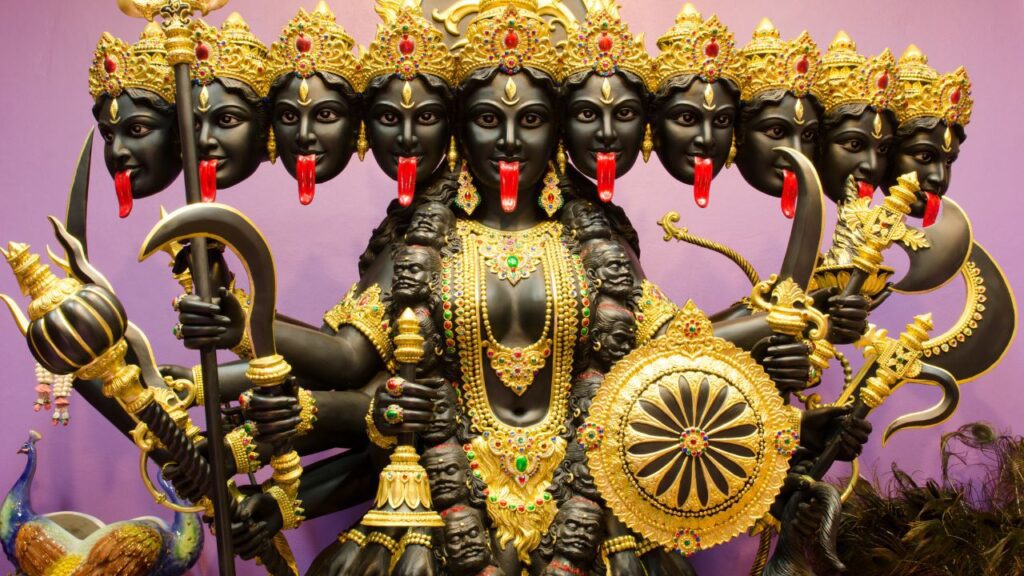
The Kali Bheej Mantra: Its transforming power
Kali worship is mostly based on chanting holy mantras, which are supposed to call the Goddess’s blessings and help the devotee to undergo spiritual development. Traditionally performed 108 times during the puja, the most famous of these is the strong incantation known as the Kali Bheej Mantra.
Tapping into the innermost core of the Goddess, the brief but potent Kali Bheej Mantra, “Om Krim Kali,” is Considered the seed (bheej) mantra of Kali, a primordial sound that speaks to her creative, destructive, and transforming forces, the syllable “Krim” is
The devotee is supposed to match the Goddess’s divine power by chanting this mantra with accuracy, sincerity, and dedication, therefore removing the barriers and illusions impeding their spiritual development. Considered to grant protection, emancipation, and the attainment of Moksha, the ultimate level of knowledge, the Kali Bheej Mantra is repeated.
The Kali Gayatri Mantra: A Greater Invocation
Apart from the Kali Bheej Mantra, the Kali Gayatri Mantra is another strong invocation exploring the multifarious character of the Goddess and her function as the Supreme Creatrix.
The Kali Gayatri Mantra expresses:
"Om Maha Kalyai Ca Vidmahe Smasana Vasinyai Ca Dhimahi Tanno Alicat"Turning into:
"Om, we consider the Great Goddess Kali, who lives in the Ocean of Life and in the Cremation Ground that dissolve the planet. May she motivate and direction us.This mantra calls Kali’s twin roles as the Mistress of the Cremation Ground and the Goddess of Time, where the cycle of birth and death is enacted. Through chanting this mantra, the devotee embraces the inevitable changes and transitions that are a normal aspect of the human experience, so aligning oneself with Kali’s transforming ability.
Worshiping Goddess Kali’s Spiritual Advantages
Giving oneself to the worship of Goddess Kali is said to bestow a myriad of spiritual advantages onto the devotee, surpassing the limits of earthly existence and guiding them towards the ultimate goal of Moksha, or emancipation.
A main advantage of Kali worship is the achievement of defense against both seen and invisible negative influences. Kali is adored as a ferocious guardian, a mother who valiantly shields her offspring from the manipulations of enemies, rivals, and evil spirits. The devotee is supposed to be protected from the negative consequences of Navagraha (the nine planetary influences) and other people’s bad intents by calling her power.
Furthermore thought to be granted by Kali’s devotion are good health, energy, and lifespan. Her position as the “Dark Mother” covers not just the negative parts of life but also the nurturing, life-sustaining traits required for both bodily and spiritual peace.
For people who have experienced injustice or have been the targets of harsh treatment, Kali’s grace seems as the last resort. Kali’s divine intervention makes things right, hence the devotee is supposed to achieve resolution and the restoration of balance in their life by turning to the Goddess.
But the achievement of Moksha, the ultimate state of release from the cycle of birth and death, is maybe the greatest great advantage of Kali worship. Kali, who represents Time and the Mistress of the Cremation Ground, is said to lead her followers toward the transcendence of the ego and the illusion of separateness, therefore guiding them to realize their actual, limitless nature.
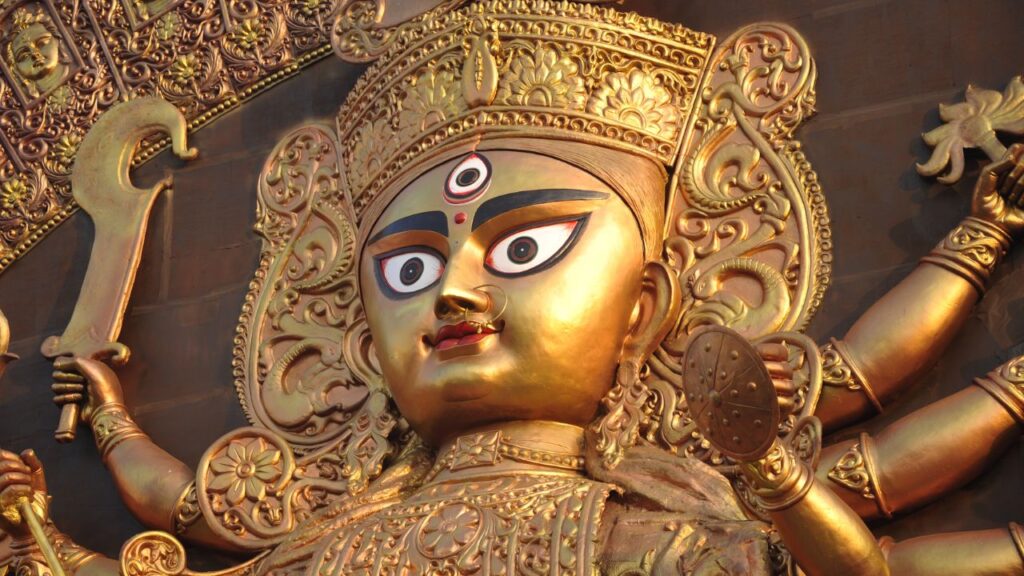
The many expressions of Goddess Kali
The alluring image of Goddess Kali has spawned a variety of separate incarnations, each with own spiritual meaning and iconography. These several incarnations of the Goddess satisfy the several demands and spiritual inclinations of her followers, therefore highlighting the width and depth of her divine essence.
One such expression of the Goddess of Knowledge, Saraswati, is violent reincarnation called Matangi Kali. Often seen with a sharp, uncompromising face, Matangi Kali uses weapons to symbolize the importance of defeating the powers of ignorance and illusion.
Another Kali form is Chinamasta, which stands for the oneness of death and creation. Often seen with her own severed head in her grasp, Chinamasta is a strong emblem for the cyclical character of life and the transcension of the ego.
Respected for her ability to lead the devotee during the most difficult life and death transitions, the terrifying incarnation of Shamsana Kali oversees the operations of the cremation. Called upon to destroy the powers of evil and darkness is Bagala Kali, a ferocious form of the Goddess.
These are only a handful of the several ways Goddess Kali could be expressed; each provides a different road for spiritual development, metamorphosis, and enlightenment attainment.
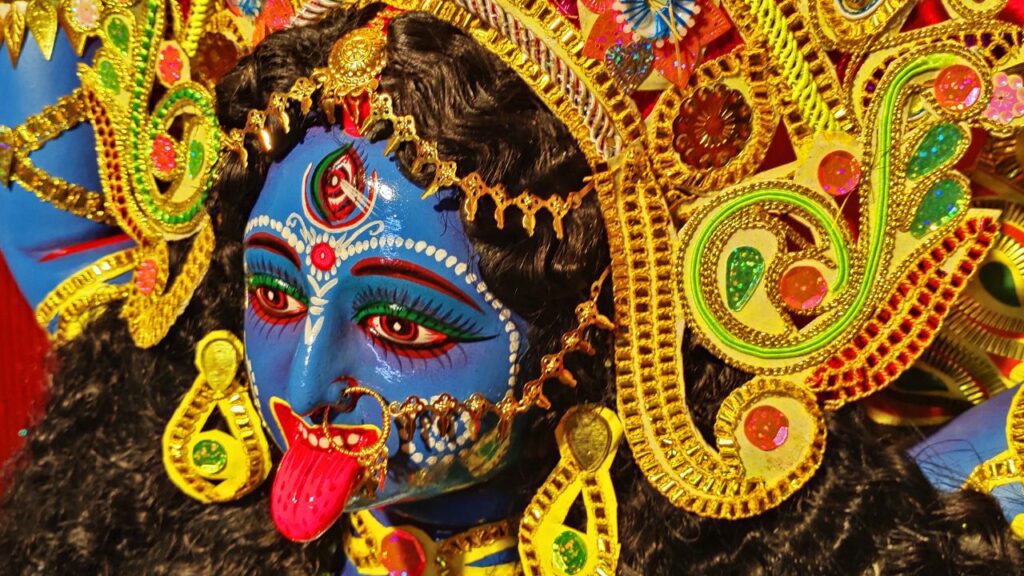
Kali Worship Within Contemporary Context
The worship of Goddess Kali has also changed remarkably as Hinduism develops and adaptable to the requirements of the contemporary society finds fresh and creative approaches to interact with her eternal lessons.
Tantric Kali worship, which stresses the Goddess’s function as the embodied divine feminine essence and the liberator from the bonds of material life, is one such development. Using Kali’s transforming power as a tool to reach spiritual enlightenment and the realization of one’s actual, limitless essence, Tantric practitioners perform certain rites and meditations meant to harness it.
Furthermore, the availability of Kali worship has changed dramatically in the internet era since followers from all around the world can interact with her lessons and take part in virtual puja celebrations. This has made Kali’s knowledge more widely available and enabled people to include her lessons into their own spiritual paths and daily life.
The importance of Goddess Kali’s teachings has only become more significant as the globe struggles with current age issues. For those trying to negotiate the complexity of the twenty-first century, her capacity to lead her followers through the cycles of destruction and rebirth and her relentless dedication to the triumph of good over evil inspire hope and motivation.
Conclusion
Rising as a towering figure in the large and fascinating pantheon of Hindu deities, Goddess Kali is a multifarious and sophisticated representation of the divine feminine. Her story, images, and spiritual practices invite followers to accept the cyclical cycle of time, the duality of creation and destruction, and the eventual release from the constraints of material illusion, therefore offering a great portal to the greatest secrets of life.
Examining the complex tapestry of Kali’s teachings helps us to find a road of spiritual development that crosses the ego and leads us toward the awareness of our actual, unlimited nature. By means of the singing of her holy mantras, the observation of auspicious rites, and the development of relentless dedication, we might release the transforming power that Goddess Kali bestows, so transformingly emerging as refreshed, powerful, and enlightened creatures.
The wisdom of Goddess Kali is a timeless lighthouse guiding us toward a deeper knowledge of the self, the universe, and the great interconnection of all things as we negotiate the often shifting terrain of the modern society. We can discover the strength, the resilience, and the spiritual fortitude to surmount the obstacles that life presents by embracing her teachings and turning to her divine grace; finally, we can reach the ultimate condition of emancipation and illumination.
#worship #benefits #worship #howto #kali #kaalimata
